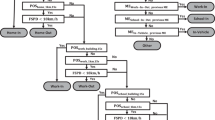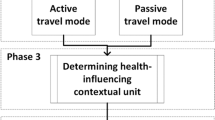Abstract
Background
Little is known about how individuals are exposed to air pollution in various daily activity spaces due to a lack of data collected in the full range of spatial contexts in which they spend their time. The limited understanding makes it difficult for people to act in informed ways to reduce their exposure both indoors and outdoors.
Objective
This study aimed to (1) assess whether personalized air quality data collected using GPS-enabled portable monitors (GeoAir2), coupled with travel-activity diaries, promote people’s awareness and behavioral changes regarding indoor and outdoor air pollution and (2) demonstrate the effect of places and activities on personal exposure by analyzing individual exposure profiles.
Methods
44 participants carried GeoAir2 to collect geo-referenced air pollution data and completed travel-activity diaries for three days. These data were then combined for spatial data analysis and visualization. Participants also completed pre- and post-session surveys about awareness and behaviors regarding air pollution. Paired-sample t-tests were performed to evaluate changes in knowledge, attitudes/perceptions, and behavioral intentions/practices, respectively. Lastly, follow-up interviews were conducted with a subset of participants.
Results
Most participants experienced PM2.5 peaks indoors, especially when cooking at home, and had the lowest exposure in transit. Participants reported becoming more aware of air quality in their surroundings and more concerned about its health effects (t = 3.92, p = 0.000) and took more action or were more motivated to alter their behaviors to mitigate their exposure (t = 3.40, p = 0.000) after the intervention than before. However, there was no significant improvement in knowledge (t = 0.897; p = 0.187).
Significance
Personal exposure monitoring, combined with travel-activity diaries, leads to positive changes in attitudes, perceptions, and behaviors related to air pollution. This study highlights the importance of citizen engagement in air monitoring for effective risk communication and air pollution management.
This is a preview of subscription content, access via your institution
Access options
Subscribe to this journal
Receive 6 print issues and online access
$259.00 per year
only $43.17 per issue
Buy this article
- Purchase on Springer Link
- Instant access to full article PDF
Prices may be subject to local taxes which are calculated during checkout






Similar content being viewed by others
Data availability
The data that support the findings of this study are not publicly available because they include personally identifiable information that could compromise research participant privacy/consent.
References
Kurt OK, Zhang J, Pinkerton KE. Pulmonary health effects of air pollution. Curr Opin Pulm Med. 2016;22:138–43.
Brook RD, Rajagopalan S, Pope CA III, Brook JR, Bhatnagar A, Diez-Roux AV, et al. Particulate matter air pollution and cardiovascular disease: an update to the scientific statement from the American Heart Association. Circulation 2010;121:2331–78.
Kampa M, Castanas E. Human health effects of air pollution. Environ Pollut. 2008;151:362–7.
Omelekhina Y, Eriksson A, Canonaco F, Prevot ASH, Nilsson P, Isaxon C, et al. Cooking and electronic cigarettes leading to large differences between indoor and outdoor particle composition and concentration measured by aerosol mass spectrometry. Environ Sci Process Impacts. 2020;22:1382–96.
Nwanaji-Enwerem JC, Allen JG, Beamer PI. Another invisible enemy indoors: COVID-19, human health, the home, and United States indoor air policy. J Expo Sci Environ Epidemiol. 2020;30:773–5.
González-Martín J, Kraakman NJR, Pérez C, Raquel Lebrero, Muñoz R. A state-of–the–art review on indoor air pollution and strategies for indoor air pollution control. Chemosphere 2021;262:128376.
Bales E, Nikzad N, Quick N, Ziftci C, Patrick K, Griswold W. Personal pollution monitoring: mobile real-time air quality in daily life. Pers Ubiquit Comput. 2019;23:309–28.
Centers for Disease Control and Prevention. Chapter 5: Indoor Air Pollutants and toxic materials; 2009 https://www.cdc.gov/nceh/publications/books/housing/cha05.htm#:~:text=In%20the%20last%20several%20years,90%25%20of%20their%20time%20indoors
Klepeis N, Nelson W, Ott W, Robinson J, Tsang A, Switzer P, et al. The National Human Activity Pattern Survey (NHAPS): A resource for assessing exposure to environmental pollutants. J Expo Sci Environ Epidemiol. 2001;11:231–52.
Oltra C, Sala R, Boso À, Asensio SL. Public engagement on urban air pollution: an exploratory study of two interventions. Environ Monit Assess. 2017;189:296.
Haddad H, de Nazelle A. The role of personal air pollution sensors and smartphone technology in changing travel behaviour. J Transp Health. 2018;11:230–43.
Schaefer T, Kieslinger B, Fabian CM. Citizen-based air quality monitoring: The impact on individual citizen scientists and how to leverage the benefits to affect whole regions. Citizen. Sci: Theory Pract. 2020;5:6.
Kim S, Paulos E, Mankoff J. InAir: a longitudinal study of indoor air quality measurements and visualizations. Proceedings of the SIGCHI Conference on Human Factors in Computing Systems; 2013; Paris, France. New York: ACM Press; 2013.
Wong-Parodi G, Dias MB, Taylor M. Effect of using an indoor air quality sensor on perceptions of and behaviors toward air pollution (Pittsburgh empowerment library study): Online survey and interviews. JMIR Mhealth Uhealth. 2018;6:e48.
Steinle S, Reis S, Sabel CE, Semple S, Twigg MM, Braban CF, et al. Personal exposure monitoring of PM2.5 in indoor and outdoor microenvironments. Sci Total Environ. 2015;508:383–94.
Hu K, Davison T, Rahman A, Sivaraman V Air pollution exposure estimation and finding association with human activity using wearable sensor network. Proceedings of the MLSDA 2014 2nd Workshop on Machine Learning for Sensory Data Analysis; 2014; Gold Coast, Australia, New York: ACM Press; 2014.
Robinson JA, Kocman D, Horvat M, Bartonova A. End-user feedback on a low-cost portable air quality sensor system—Are we there yet? Sensors 2018;18:3768.
Park YM. A GPS-enabled portable air pollution sensor and web-mapping technologies for field-based learning in health geography. J Geogr High Educ. 2022;46:241–61.
Park YM, Sousan S, Streuber D, Zhao K. GeoAir—A novel portable, GPS-enabled, low-cost air-pollution sensor: Design strategies to facilitate citizen science research and geospatial assessments of personal exposure. Sensors 2021;21:3761.
Ma J, Tao Y, Kwan M-P, Chai Y. Assessing mobility-based real-time air pollution exposure in space and time using smart sensors and GPS trajectories in Beijing. Ann Am Assoc Geogr. 2020;110:434–48.
Wang J, Kou L, Kwan M-P, Shakespeare RM, Lee K, Park YM. An integrated individual environmental exposure assessment system for real-time mobile sensing in environmental health studies. Sensors 2021;21:4039.
Sousan S, Regmi S, Park YM. Laboratory evaluation of low-cost optical particle counters for environmental and occupational exposures. Sensors 2021;21:4146.
Streuber D, Park YM, Sousan S. Laboratory and field evaluations of the GeoAir2 air quality monitor for use in indoor environments. Aerosol Air Qual Res. 2022;22:220119.
Patridge EF, Bardyn TP. Research Electronic Data Capture (REDCap). J Med Libr Assoc. 2018;106:142–4.
Glasgow ML, Rudra CB, Yoo EH, Demirbas M, Merriman J, Nayak P, et al. Using smartphones to collect time-activity data for long-term personal-level air pollution exposure assessment. J Expo Sci Environ Epidemiol. 2016;26:356–64.
Park YM, Lee, K. Combining GPS and Wi-Fi data for improved indoor positioning and automated detection of microenvironments for location data. Unpublished manuscript.
AirNow. Air Quality Index (AQI) | AirNow.gov. https://www.airnow.gov/aqi/
Sharma R, Balasubramanian R. Evaluation of the effectiveness of a portable air cleaner in mitigating indoor human exposure to cooking-derived airborne particles. Environ Res. 2020;183:109192.
Bhadauria V, Parmar D, Ganguly R, Rathi AK, Kumar P. Exposure assessment of PM2.5 in temple premises and crematoriums in Kanpur, India. Environ Sci Pollut Res. 2022;29:38374–84.
Goel A, Wathore R, Chakraborty T, Agrawal M. Characteristics of exposure to particles due to incense burning inside temples in Kanpur, India. Aerosol Air Qual Res. 2017;17:608–15.
Ott WR Human activity patterns: A review of the literature for estimating time spent indoors, outdoors, and in transit. Proceedings of the Research Planning Conference on Human Activity Patterns; EPA National Exposure Research Laboratory, EPA/600/4-89/004; 1989; Las Vegas, NV; 1989.
Boso À, Álvarez B, Oltra C, Garrido J, Muñoz C, Hofflinger Á. Out of sight, out of mind: Participatory sensing for monitoring indoor air quality. Environ Monit Assess. 2020;192:104.
Woodall GM, Hoover MD, Williams R, Benedict K, Harper M, Soo J-C, et al. Interpreting mobile and handheld air sensor readings in relation to air quality standards and health effect reference values: Tackling the challenges. Atmosphere. 2017;8:182.
Funding
Research reported in this publication was supported by the National Institute of Environmental Health Sciences of the National Institutes of Health (NIH) under Award Number P30ES025128. The content is solely the responsibility of the authors and does not necessarily represent the official views of the NIH.
Author information
Authors and Affiliations
Contributions
YMP conceptualized the study, designed the methodology, developed study materials, performed the spatial data analyses and visualization, interpreted the results, and wrote the manuscript. DC performed statistical analyses and drafted a portion of the methods section. YMP and DC led the data collection. SS contributed to the design of the study. NF-B, JRA, and JR-P contributed to the development of study materials, data collection, and result interpretation. YMP and SS secured funding for the research study. All authors reviewed and edited the manuscript and approved the final version.
Corresponding author
Ethics declarations
Competing interests
The authors declare no competing interests.
Ethical approval
The project protocol and materials were approved by the University and Medical Center Institutional Review Board at East Carolina University on June 16, 2020 (IRB#: UMCIRB 20-001302).
Additional information
Publisher’s note Springer Nature remains neutral with regard to jurisdictional claims in published maps and institutional affiliations.
Supplementary information
Rights and permissions
Springer Nature or its licensor (e.g. a society or other partner) holds exclusive rights to this article under a publishing agreement with the author(s) or other rightsholder(s); author self-archiving of the accepted manuscript version of this article is solely governed by the terms of such publishing agreement and applicable law.
About this article
Cite this article
Park, Y.M., Chavez, D., Sousan, S. et al. Personal exposure monitoring using GPS-enabled portable air pollution sensors: A strategy to promote citizen awareness and behavioral changes regarding indoor and outdoor air pollution. J Expo Sci Environ Epidemiol 33, 347–357 (2023). https://doi.org/10.1038/s41370-022-00515-9
Received:
Revised:
Accepted:
Published:
Issue Date:
DOI: https://doi.org/10.1038/s41370-022-00515-9
Keywords
This article is cited by
-
Piloting co-developed behaviour change interventions to reduce exposure to air pollution and improve self-reported asthma-related health
Journal of Exposure Science & Environmental Epidemiology (2024)
-
School and childcare facility air quality decision-makers’ perspectives on using low-cost sensors for wildfire smoke response
BMC Public Health (2023)
-
Science communication on the public health risks of air pollution: a computational scoping review from 1958 to 2022
Archives of Public Health (2023)



